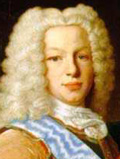 |
Fernando VIb. 23 Sep 1713, Madrid [1] |
| Title: | Por la gracia de Dios, Rey de Castilla, de León, de Aragón, de las dos Sicilias, de Jerusalén, de Navarra, de Granada, de Toledo, de Valencia, de Galicia, de Mallorca, de Sevilla, de Cerdeña, de Córdoba, de Córcega, de Murcia, de Jaén, del Algarve, de Algeciras, de Gibraltar, de las Islas Canarias, de las Indias Orientales y Occidentales, de las Islas y Tierrafirme del Continente Oceánico, Archiduque de Austria, Duque de Borgoña, de Brabante y de Milán, Conde de Abspurg, de Flandes, del Tirol y de Barcelona, Señor de Vizcaya y de Molina, etc. (By the Grace of God, King of Castile, of Leon, of Aragon, of the Two Sicilies, of Jerusalem, of Navarre, of Granada, of Toledo, of Valencia, of Galicia, of Mallorca, of Seville, of Sardinia, of Cordoba, of Corsica, of Murcia, of Jaen, of the Algarve, of Algeciras, of Gibraltar, of the Canary Islands, of the East and West Indies, of the Islands and Mainland of the Ocean Continent, Archduke of Austria, Duke of Burgundy, of Brabant and Milan, Count of Habsburg, of Flanders, of Tyrol, and of Barcelona, Lord of Vizcaya and of Molina, etc.) [3] |
| Term: | 9 Jul 1746 - 10 Aug 1759 |
| Chronology: | 9 Jul 1746, succeeded to the throne (proclaimed king at San Lorenzo el Real, now San Lorenzo de El Escorial, near Madrid) [4] |
| 10 Aug 1759, died | |
| Names/titles: | Baptized (25 Aug 1716): Fernando; private name: Fernando de Borbón y Saboya; Príncipe de Asturias (Prince of Asturias) [25 Aug 1707 - 15 Jan 1724] |
| Biography: | |
Fourth son of of King Felipe V and Maria Luisa of Savoy; became heir apparent to the throne after premature deaths of his bothers, Felipe (29 Dec 1719) and Luis I (31 Aug 1724); was solemnly installed as Prince of Asturias and received homage at the Monastery of San Jerónimo, Madrid (25 Nov 1724); married Maria Madalena Bárbara Xavier Leonor Teresa Antónia Josefa de Bragança (20 Jan 1729), daughter of King João V of Portugal; succeeded his father (1746); retained his father's chief domestic secretary, Zenón de Somodevilla y Bengoechea, marqués de la Ensenada, as the head of several government departments, although he named José de Carvajal y Lancaster as his own chief foreign secretary to temper Ensenada's power; continued to participate in the War of the Austrian Succession (1740–1748) which ended with the Treaty of Aix-la-Chapelle, granting the duchies of Parma, Piacenza, and Guastalla to Fernando's half-brother Felipe and putting an end to thirty years of Spanish intervention in Italy; susceptible to melancholy, he found great interest in music and patronizing arts; asserted the position of the Crown by signing of the Concordat of 1753; the death of Carvajal (8 Mar 1754) impelled the king to appoint as his first secretary Ricardo Wall y Devreux, an Anglophile, who helped shift Spain's foreign policy to pacifism, avoiding involvement in international alliances, even after the eruption of the Seven Years' War in 1756; being particularly devoted to his wife whose death (27 Aug 1758) resulted in the king's mental collapse, which degenerated into madness until his death in Villaviciosa de Odón in 1759. Biography source: [5][6] |
|
| | |
| [1] | Gaceta de Madrid, del martes 26 de Septiembre de 1713. Núm. 39. P. 156: "El Sabado 23. del corriente, à las quatro y media de la mañana, pariò la Reyna nuestra ſeñora con ſuma felicidad al Sereniſsimo ſeñor Infante D. Fernando..." |
| [2] | Gaceta de Madrid, del martes 14 de Agosto de 1759. Núm. 33. P. 263: "El Viernes diez de este mes, à las quatro y quarto de la mañana, tuvieron ſu indiſspenſable termino los males de nuestro amado Rey Don Fernando el Sexto..." |
| [3] | On coins: DEI GRATIA HISPAN[IARUM] ET IND[IARUM] REX (By the Grace of God, King of the Spains and the Indies). |
| [4] | Gaceta de Madrid, del martes 18 de Enero de 1724. Núm. 3. P. 12. |
| [5] | "Fernando VI y Doña Bárbara de Braganza (1713-1748)", by Alfonso Danvila (Madrid: Imprenta de Jaime Ratés Martín, 1905). |
| [6] | "Fernando VI", by Pedro Voltes Bou (Barcelona: Planeta, 1996). |
